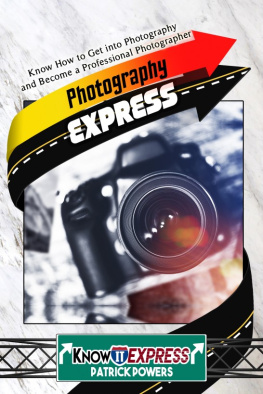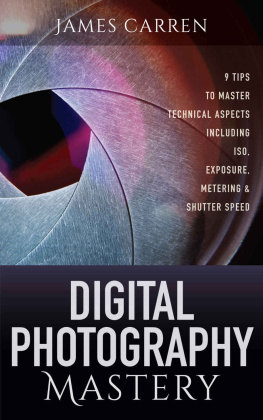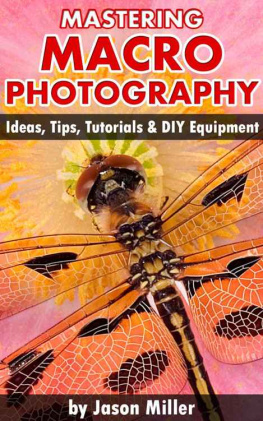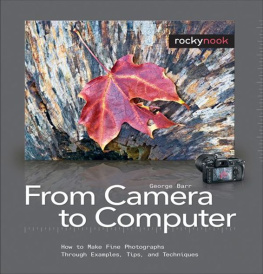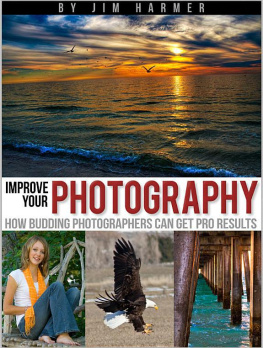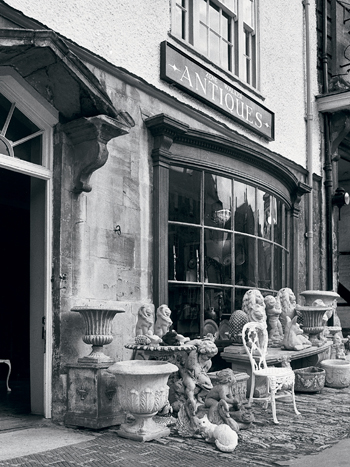Take Your Photography to the Next Level
Take Your Photography to the Next Level
From Inspiration to Image
George Barr
Editor: Gerhard Rossbach
Copyeditor: Joan Dixon
Layout and Type: Almute Kraus, www.exclam.de
Cover Design: Helmut Kraus, www.exclam.de
Cover Photo: George Barr
Printer: Friesens Corporation, Altona, Canada
Printed in Canada
ISBN 978-1-933952-21-5
1st Edition
2008 by Rocky Nook Inc.
26 West Mission Street Ste 3
Santa Barbara, CA 93101
www.rockynook.com
Library of Congress catalog application submitted
Distributed by OReilly Media
1005 Gravenstein Highway North
Sebastopol, CA 95472
All product names and services identified throughout this book are trademarks or registered trademarks of their respective companies. They are used throughout this book in editorial fashion only and for the benefit of such companies. No such uses, or the use of any trade name, is intended to convey endorsement or other affiliation with the book.
No part of the material protected by this copyright notice may be reproduced or utilized in any form, electronic or mechanical, including photocopying, recording, or by any information storage and retrieval system, without written permission of the copyright owner.
This book is printed on acid-free paper.
Foreword
There is a story that Pablo Picasso is reported to have once commented that photography isnt an art, because anyone with a camera can take a photograph. With all due respect to Mr. Picasso, thats like saying that anyone that owns a piano is a pianist.
Photography is an art form that relies heavily on equipment for its actualization, maybe more so than any other. This turns out to be both a blessing and a curse. Certainly todays auto-everything digital wonder-cameras do indeed allow almost anyone to take a well-exposed, properly focused image. But whether the photograph has any artistic merit beyond being simply a record of what was in front of the camera at the moment the shutter was pressed, is totally reliant on the person that pressed the shutter.
That is what lies at the core of Take Your Photography to the Next Level. Not the equipment, (though the right equipment for the task is an important ingredient), and not necessarily any pre- or post-exposure techniques used, though these too are important. Rather, it is that almost ephemeral connection between art and craft that defines the level at which one practices photography.
Practice is indeed the right word, because as with any art or craft it is practice which informs excellence. There is a story that the virtuoso violinist Jascha Heifitz, still performing publicly in his 80s, was visited in his hotel room during a tour. When the reporter entered the room he found Heifitz practicing, and asked why, after a half century as one of the worlds greatest performers on that instrument, he still needed to practice. Heifitzs reply was telling. He said that if he didnt practice almost every day it was unlikely that anyone in the audience would notice. But, after a few days of not practicing, he, Heifitz, would hear the difference. And it is that type of dedication to art and craft that leads to greatness.
I met George Barr when he attended one of my field workshops. During the print review session it was immediately clear that Georges work stood apart from that of his contemporaries. There was a depth of visual perceptivity that goes beyond experience and practice, but is found only when a photographer has thought long and hard about their work and its goals.
After a half century pursuing his art, a couple of years ago George started writing a series of articles for The Luminous Landscape website. These proved to be among the most inspirational essays to appear on my site, and have received wide praise. Now, this new book takes the germ of that series and expands them into a comprehensive guide for photographers who wish to grow as creative artists through a better understanding of their art, as well as their craft.
Michael Reichmann
Luminous Landscapes
Toronto, Canada
August 2007
Introduction
In 2006, after publishing a popular series of articles on the website OutbackPhoto.com, I started writing my own photography blog. I discovered that I could explain things clearly, and with more than 40 years of photographing I could contribute some useful ideas to the craft.
I could have written my blog about technical matters, but there was already a lot of that kind of material out there. And so, from the beginning, I leaned towards tackling the more difficult questions in photography; issues such as making great images, finding inspiration, working the scene, and pitfalls to avoid (usually learned from personal experience). This year, I wrote a three-article series on Taking Your Photography To The Next Level, which formed the basis for this book. What follows are a series of essays on specific solutions to common creative problems, followed by that three-part series.
My background is as a family doctor, a profession that can involve a lot of teaching and explaining. It is a part of my career that I especially enjoy. For years I wrote a patient newsletter. I have taught sailboat racing and computers and photography. I seem to have an ability to explain things clearlysomething that medical specialists often dont possessand patients come to me to translate what the specialist said.
That is all very well, but I strongly believe that before you pay attention to any advice I might have, you need to satisfy yourself that here is a photographer who makes images worth looking at. Its possible to teach without actually doing, but most good teachers are good doers, as well. I would guess you already flipped through this book, but if you havent, take a few moments to check out the portfolio of images following this introduction. You can then decide if you can relate to my images, and if you like them enough to fork out the money for this book, to invest the time to read it, and especially, to act on some of the advice and suggestions this book has to offer.
Were this just a reprint of my articles and blog entries, with a few pictures tossed in for show, it could still be a nice book to haveeasier to flip through and read than online text. Fortunately though, its much more than just that. I have taken the best from over 500 blog entries and rewritten them, providing specific helpful illustrations and examples. I have added text where helpful, pared down when appropriate, and clarified as needed. Some of the essays are completely new, while all have been improved upon. The essays included in this book, while not specifically forming a point A to point B textbook, do in fact cover much of the process of being a photographer and of making great images.
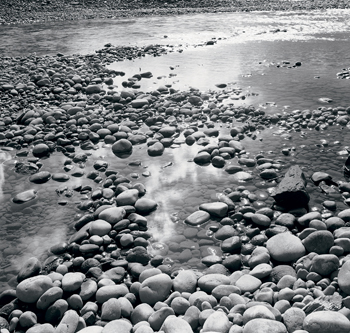
The title suggests that Im going to handle the difficult issues. So just what the heck does that mean? Well, for a start, this isnt a book about f-stops and shutter speeds: Its about making art, dealing with frustrations and disappointments, and how to grow as a photographer. In this book you will learn how to work the scene, what some of the pitfalls are and how to avoid them, and what the characteristics are of great images. I discuss what photographs well and I go into the whole topic of good composition and how to create it. There are many books that talk about creativity in a vague or general sense, or they simply discuss it philosophically. I take some of those same difficult questions, and suggest practical and specific strategies for solving these problems.
Next page

